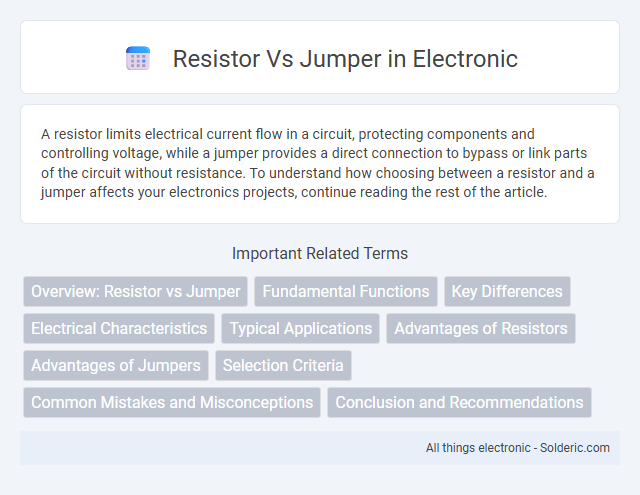A resistor limits electrical current flow in a circuit, protecting components and controlling voltage, while a jumper provides a direct connection to bypass or link parts of the circuit without resistance. To understand how choosing between a resistor and a jumper affects your electronics projects, continue reading the rest of the article.
Comparison Table
| Feature | Resistor | Jumper |
|---|---|---|
| Function | Limits or controls electrical current | Connects two points directly, creating a short circuit |
| Resistance | Has a fixed resistance value (ohms) | Negligible or zero resistance |
| Purpose | Used in circuits for current regulation and voltage division | Used to close or open circuit paths |
| Appearance | Cylindrical body with color bands indicating resistance | Short wire or connector |
| Application | Electronics, signal conditioning, power management | Circuit configuration and testing |
| Symbol | zigzag or rectangle | straight line or dot connecting two points |
Overview: Resistor vs Jumper
A resistor limits electrical current and controls voltage within circuits by providing specific resistance measured in ohms, essential for protecting components and managing signal levels. A jumper, in contrast, is a simple conductive connector that creates a direct electrical connection between two points, effectively bypassing other circuit elements. While resistors regulate current flow, jumpers enable flexible circuit configuration and testing by establishing or breaking connections.
Fundamental Functions
A resistor controls electric current flow by providing resistance, which helps regulate voltage and protect circuit components, while a jumper simply creates a direct electrical connection between two points without resistance. Your circuit design relies on resistors to manage current levels accurately, whereas jumpers are used for bridging circuit paths or configuring connections. Understanding these fundamental functions ensures proper component selection for efficient and safe electronic performance.
Key Differences
Resistors and jumpers serve distinct functions in electronic circuits; resistors limit current flow by providing precise resistance measured in ohms, while jumpers create a direct electrical connection with negligible resistance to complete or alter circuit paths. Resistors are essential for controlling voltage and current, protecting components, and ensuring signal integrity, whereas jumpers primarily facilitate circuit testing, configuration, and debugging by bridging gaps on a PCB. Your choice between the two depends on whether your application requires current regulation or simple connectivity.
Electrical Characteristics
Resistors provide a precise resistance value measured in ohms, limiting electrical current flow and dissipating power as heat, while jumpers offer virtually zero resistance, creating a direct electrical connection for signal or power pathways. The electrical characteristics of resistors include tolerance, power rating, and temperature coefficient, which affect circuit stability and performance. You should use resistors when controlled current or voltage drop is needed, whereas jumpers are suited for bypassing or simple on/off circuit configurations.
Typical Applications
Resistors are commonly used in circuits to limit current, divide voltages, and dissipate power in applications such as LED drivers, signal conditioning, and voltage regulation. Jumpers serve as simple connectors to configure or reconfigure circuit paths, enabling options like setting hardware modes or enabling/disabling features on PCBs. Your choice depends on whether you need controlled resistance for precise functionality or a direct connection for flexible circuit customization.
Advantages of Resistors
Resistors provide precise control of electrical current, enabling you to protect sensitive components and manage voltage levels effectively in a circuit. Unlike jumpers, resistors offer predictable resistance values that improve circuit stability and performance. Their ability to dissipate heat and regulate current flow makes them essential for reliable and safe electronic designs.
Advantages of Jumpers
Jumpers provide a straightforward and flexible connection solution, enabling quick circuit modifications without soldering or permanent installations. Their reusable design reduces maintenance time and material costs in prototyping and testing environments. Unlike resistors, jumpers offer negligible resistance, ensuring minimal voltage drop and preserving signal integrity in electrical circuits.
Selection Criteria
Resistor selection criteria include resistance value, power rating, tolerance, and temperature coefficient to ensure proper circuit protection and signal control. Jumpers are chosen based on their size, pin configuration, and current rating, which primarily enable circuit customization or connection bridging without resistance. The choice depends on whether the application requires controlled resistance or simple electrical connectivity.
Common Mistakes and Misconceptions
Confusing a resistor with a jumper often leads to circuit malfunctions, as resistors provide controlled resistance while jumpers serve as direct conductive links. Beginners frequently misuse jumpers expecting voltage drop or current limitation, which only resistors can achieve due to their fixed resistance values. Understanding the distinct electrical roles and symbols of resistors versus jumpers prevents errors in circuit design and troubleshooting.
Conclusion and Recommendations
Resistors regulate current flow and protect circuits, while jumpers provide direct electrical connections without resistance. For precise control and voltage division, resistors are essential; use jumpers mainly for testing or bypassing circuits. Choose resistors for stability and safety, and jumpers for temporary or simple connections.
resistor vs jumper Infographic

 solderic.com
solderic.com